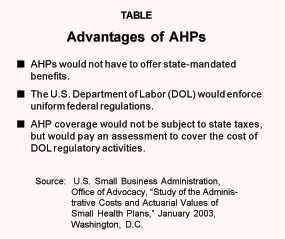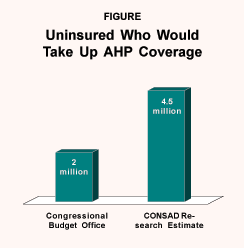The Congressional Budget Office (CBO) reported this month that while the number of chronically uninsured Americans is lower than commonly believed (between 21 million and 31 million, rather than 41 million), the number of Americans who go without health insurance for brief periods is around 60 million. State regulations and a lack of competition in the health insurance market are making this problem worse.
Congress is contemplating ways to make health insurance more affordable. One promising reform would encourage Association Health Plans (AHPs) and could bring coverage to as many as 4.5 million currently uninsured Americans, provided Congress creates the right regulatory environment.
Problem: Costly Regulations
State governments regulate health insurance excessively. In addition to taxes, price controls and regulations governing access to insurance, states require buyers of health insurance to pay for extra benefits they may not want. For example:
- Mandated benefits require that health insurance plans include coverage for services ranging from acupuncture to in-vitro fertilization and for providers ranging from chiropractors to naturopaths.
- Mandates require coverage for bone marrow transplants in New Jersey, clinical trials in Virginia, hairpieces in Minnesota, marriage counseling in Connecticut and pastoral counseling in Maine.
- Nationwide, more than 1,000 such mandates exist.
Mandates make health insurance more expensive. As a result, fewer people can afford to insure. Studies estimate that as many as one out of every four uninsured Americans has been priced out of the health insurance market by these regulations.
Problem: Shrinking Competition
In most of the United States, a few large firms dominate the health insurance marketplace, leaving consumers with few choices and many unmet needs. For example, the five largest insurers represented three-quarters or more of the small group insurance market in 19 of 34 states supplying information for a General Accounting Office Survey. In Oklahoma, Connecticut, Idaho, Maine, Maryland, North Dakota and Vermont, the five largest carriers have more than 90 percent of the market.
Indeed, many cities and towns are served by only one insurer. In these markets, products are often offered on a "take it or leave it" basis. They may be overpriced, with benefits that do not fit the needs of many firms and many individuals. But with few or no alternatives, buyers must purchase an imperfect substitute for the type of insurance they prefer or forgo insurance altogether.
A Partial Solution: AHPs
Association Health Plans are health plans created for individuals and groups who belong to an association related to their jobs, careers, hobbies or interests. The United States has some 15,000 associations. By uniting many individuals and small groups with similar interests across the country, AHPs could provide economies of scale to lower health care costs for their members. Some six million Americans are already insured through associations and the number is growing. For example:
- AARP offers supplemental medical insurance to all of the Medicare enrollees among its 35 million dues-paying members.
- The National Association for the Self-Employed (NASE) makes AHP insurance available to its members throughout the country.
- With expanded availability, the National Restaurant Association could offer AHPs to restaurant employees in all 50 states, and the National Rifle Association could offer insurance to its members.
The potential for growth of this type of insurance is quite large – given a favorable regulatory climate.
Proposed Legislation
The existence of 50 sets of state regulations is a barrier to low-cost AHP health insurance. Large companies that "self-insure" avoid this problem. Even though the companies may have employees in all 50 states, the insurance is federally regulated under the Employee Retirement Income Security Act (ERISA). If small firms could buy AHP insurance with uniform regulations, they could enjoy the same lower administrative costs and greater bargaining power as large firms. AHPs also would be able to avoid mandated benefits and other complex, cost-increasing regulations imposed in different states. [See the Table.] Legislation to achieve these objectives is now before the Congress:
[See the Table.] Legislation to achieve these objectives is now before the Congress:
- A CBO analysis of the proposed legislation estimates that it would enable small businesses to reap savings averaging between 9 percent and 25 percent of their health insurance premium costs.
- As a result, the CBO estimates that 330,000 – and potentially as many as 2 million – of the currently uninsured would obtain health insurance. [See the Figure.]
- The CONSAD Research Corporation estimates that expanding AHPs could extend employer-sponsored insurance coverage to approximately 2.3 million employees and 2.2 million dependents.

Making the Proposal Better: Allow Risk-Based Underwriting.
Existing AHP proposals would impose "guaranteed issue" requirements on health plans, allowing individuals to join as individuals – regardless of health status. This is the equivalent of forcing auto insurers to cover drivers who wait until after they have an accident to purchase insurance. Guaranteed issue laws drive desirable risks out of the market, increase costs and are one of the main reasons state-regulated insurance is unaffordable for so many. While federal law requires group purchasers to issue insurance to all members of the group, states generally do not require that the issuer "guarantee" to cover all individuals who apply. Congress should adopt the latter practice for AHPs.
Making the Proposal Better: Harmonized Solvency Standards.
AHP proposals also would subject AHPs to looser solvency regulations than other health plans. Some worry that fly-by-night associations might endanger consumers by offering coverage they could not deliver. Congress could alleviate this concern by imposing solvency requirements similar to those insurers currently face.
Making the Proposal Better: A Market for Regulation.
Exclusive federal regulation of AHPs runs the risk of sticking consumers with rules that over time could become even more burdensome than those of the states. Allowing AHPs to choose the state that regulates their health plan would give associations the uniform regulation they desire. In addition, it would pressure the states to eliminate the costly, unwise regulations that now cost so many Americans their health coverage.
The answer to insuring the uninsured is to increase competition. By making AHPs more competitive, we can lower the cost of insurance for millions of Americans, including small employers, their employees and the self-employed.
Donald L. Westerfield, Ph.D., is a professor at Webster University and a senior fellow with the National Center for Policy Analysis. This Brief Analysis is based on a longer study by Dr. Westerfield, "Insuring the Uninsured through Association Health Plans," NCPA Policy Report No. 259.